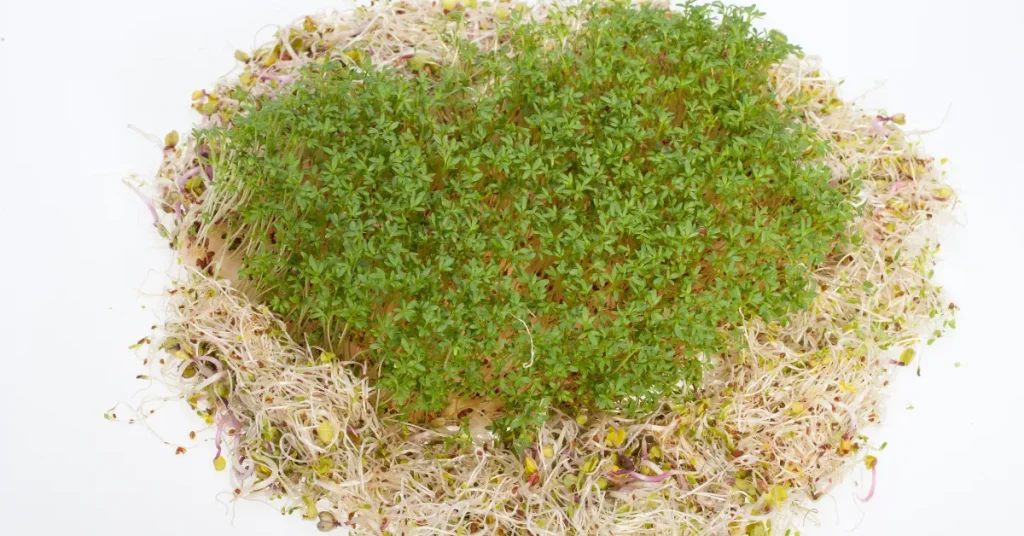Alfalfa roots can penetrate the soil up to 15 feet deep. These robust roots allow the plant to access deep water sources.
The alfalfa plant, Medicago sativa, is a powerhouse in the world of agriculture, celebrated for its nutritional value as livestock fodder and its environmental benefits.
Deeply rooted, alfalfa serves as an excellent soil conditioner, promoting soil health by enhancing porosity and nutrient content.
Its hardy root system makes it a drought-resistant crop, capable of thriving in various climates. Farmers prize alfalfa for its high protein content, which in turn supports milk production in dairy cows.
As a perennial crop, alfalfa’s long roots also play a critical role in carbon sequestration, contributing to sustainable farming practices and a healthier atmosphere.

The Hidden Depths Of Alfalfa Roots
Alfalfa, a plant that dazzles with its green shoots above, hides a secret underworld beneath the soil.
This secret is its roots, stretching far deeper than one might expect. Here we will explore the marvel of alfalfa roots, famous for their incredible reach underground.
Factors Influencing Root Growth
- Soil Quality: Compacted or nutrient-poor soil can limit how deep roots can go.
- Water Availability: Roots chase moisture; more water means deeper roots.
- Temperature: Roots grow best in warm, not hot, soil temperatures.
- Plant Variety: Some alfalfa strains have roots that grow deeper than others.
Record Measurements In Alfalfa Root Depth
Studies of alfalfa root systems reveal surprising depths. Here’s how deep they can grow:
| Age of Plant | Typical Root Depth |
| 1 Year | Up to 15 feet |
| 3 Years | Can reach over 20 feet |
| Mature Plant | Potentially 30 feet or deeper |
Note: These depths are not fixed. They change based on the factors above.
Alfalfa’s Adaptations To Soil And Environment
Alfalfa, a plant with remarkable resilience, thrives in diverse environmental conditions. Its root system is a marvel of natural engineering, allowing it to access water and nutrients in a way that many crops cannot.
This characteristic makes alfalfa an ideal choice for farmers seeking a hardy crop that can withstand variable soil conditions and climactic challenges.
Surviving Drought: Root System Efficiency
Alfalfa roots delve deep into the earth, seeking moisture from depths well beyond the reach of many plants.
During periods of drought, these roots continue to absorb water, ensuring the plant’s survival and productivity. The efficiency of alfalfa’s root system is seen in its capacity to:
- Reach depths of up to 15 feet or more.
- Extract water from deeper soil layers.
- Reduce reliance on surface water.
Soil Type And Nutrient Access
Soil is more than just dirt beneath our feet; it’s a complex ecosystem that offers nutrients to plants like alfalfa. Despite its preference for well-drained, loamy soils, alfalfa adapts to various soil types by:
| Soil Type | Adaptation |
| Clay | Deep roots break up dense layers, improving aeration. |
| Sandy | Root hairs increase surface area for moisture absorption. |
| Calcareous | Roots access lower soil acidity beneficial for growth. |
The remarkable root system of alfalfa not only survives in various soils but also helps in improving soil structure over time. Farmers benefit from this as alfalfa prepares fields for future crops, enhancing sustainability in agriculture.
Agricultural Implications Of Deep Root Systems

Alfalfa, a powerhouse in the plant world, boasts roots that can dive up to 20 feet deep. These deep roots are not just a wonder of nature but hold the key to a wealth of benefits in the agricultural world.
Understanding the potential these roots offer can transform farming practices.
Crop Rotation And Soil Health Benefits
When alfalfa takes part in a crop rotation system, it does wonders for soil health. Here is a breakdown of its benefits:
- Enhances soil structure by allowing its roots to channel deep into the ground.
- Reduces erosion by stabilizing the soil.
- Improve water infiltration, as the deep roots create pathways.
- Increases organic matter and nutrient levels through root decay.
- Promotes beneficial microbial activity.
| Benefit | Impact on Farming |
| Deep Root System | Better soil structure and reduced erosion |
| Organic Matter | Increase in nutrient-rich soil |
| Water Infiltration | Less water runoff and healthier crops |
Challenges In Harvesting And Crop Management
While the depth of alfalfa roots can be a boon, it also presents unique challenges:
- Harvesting difficulty as deep roots can be tough to remove.
- Crop management needs careful planning around alfalfa’s lifecycle.
- Possible water competition with neighboring, shallow-rooted plants.
- Diseases can be hard to detect in the hidden depths of the roots.
| Challenge | Consideration in Management |
| Root Removal | Advanced machinery or techniques may be required |
| Crop Lifespan | Comprehensive field planning |
| Water Use | Irrigation adjustments around alfalfa fields |
| Disease Management | Regular deep soil tests and monitoring |
Ecological Impact Of Alfalfa’s Root Network
The ecological footprint of alfalfa extends far below its green exterior. Its roots, some reaching depths of 15 to 20 feet, anchor it into the earth’s sub-layers.
This extensive root network impacts ecology in remarkably positive ways. Let’s delve into how this happens.
Erosion Control And Groundwater Recharge
Alfalfa’s deep roots play a vital role in preventing soil erosion. Their length stabilizes soil, holding it together even during heavy rains. This protection keeps the topsoil, rich in nutrients, where it belongs. Below are the key benefits:
- Reduction of runoff: Roots absorb water, lessening surface flow.
- Soil structure maintenance: Roots create channels that combat compaction.
- Preservation of fertile land: Root-bound soil stays productive.
These roots are also natural groundwater rechargers. As they let rainwater percolate deep into the earth, they replenish aquifers. Groundwater levels stay healthy thanks to alfalfa.
Biodiversity And Habitat Creation Underground
Alfalfa’s subterranean labyrinth is a haven for microorganisms. Its roots create a living space for various soil dwellers. This biodiversity is a cornerstone of any thriving ecosystem. Here’s what happens beneath the surface:
| Root Depth | Soil Layer | Biodiversity Contribution |
| 1-4 feet | Topsoil | Worms and beetles thrive, breaking down organic matter. |
| 4-10 feet | Subsoil | Fungi and bacteria promote nutrient cycling. |
| 10-20 feet | Substratum | Deeper organisms benefit from root exudates. |
As these creatures live and work, they boost soil fertility and resilience. Balanced underground ecosystems result from the life alfalfa’s roots support. Overall, the plant’s deep-reaching roots not only sustain themselves but nourish the land they inhabit.
Future Research And Sustainable Farming Practices

Exploring the depths of alfalfa roots unveils a world of potential for future agriculture. Research in this area is vital for enhancing farming sustainability.
Understanding how deep these roots go helps farmers use water more efficiently. It also improves soil health. This has big benefits for our environment.
Innovations In Measuring Root Depths
Digging into the earth to measure alfalfa roots is tough work. Scientific advances are making it easier. New tools help us see how roots grow without digging. Some methods use sound, electricity, or even computer imaging. Let’s review key breakthroughs:
- Ground-penetrating radar: This technology sends waves into the ground. It shows how deep roots go.
- Electrical resistivity: Plant roots conduct electricity differently than soil. By measuring resistance, we can map root systems.
- 3D computer modeling: Computer scans can create a picture of the root network. This shows us the depth and spread of alfalfa roots.
Integrating Alfalfa In Sustainable Agriculture Models
The roots of the alfalfa plant do more than reach deep into the soil—they are key players in eco-friendly farming. Here are ways alfalfa helps farms stay green:
| Rural Impact | Details |
| Soil Fertility | Deep roots pull up nutrients, making the soil better for future crops. |
| Water Management | Roots that go deep use less irrigation and prevent erosion. |
| Weed Control | The thick growth of alfalfa can stop weeds without using chemicals. |
Incorporating alfalfa into crop rotations is smart. It can reduce pests and diseases. Farmers may need fewer chemicals. This makes farming safer and cleaner.
Research is exploring more ways to use this amazing plant. Our aim is to help farms everywhere thrive for years to come.
FAQs About How Deep Do Alfalfa Roots Go
How Deep Can Alfalfa Roots Grow?
Alfalfa roots can grow exceptionally deep, often reaching depths of 15 to 20 feet or more under optimal conditions. This extensive root system allows the plant to access deep soil moisture and nutrients.
What Factors Affect Alfalfa Root Depth?
Several factors can influence the depth of alfalfa roots, including soil type, soil compaction, moisture availability, and the age of the alfalfa plant. Looser, well-drained soils typically encourage deeper root growth.
Are Alfalfa Roots Beneficial For Soil Health?
Yes, alfalfa roots are beneficial for soil health. They help in improving soil structure, increasing organic matter, and enhancing nutrient cycling. Their deep penetration also helps to reduce soil erosion.
Does Alfalfa Root Depth Vary With Seasons?
Alfalfa root depth can vary with seasons, often growing deeper in search of moisture during dry periods and retracting slightly during colder seasons. Seasonal changes can influence root growth patterns.
Conclusion
Alfalfa roots’ depth is impressive, often reaching up to 15 feet or more. This extensive root system supports robust growth and resilience, even in less-than-ideal conditions.
Understanding the root dynamics can greatly benefit crop management and soil health. Embrace the power of alfalfa’s roots for sustainable agriculture success.
Resources:
1. https://extension.umn.edu/corn-cropping-systems/managing-rotation-alfalfa-corn
